Contents
The Hostess potato is a new promising type of crop, the popularity of which is growing every year among gardeners living in regions with difficult climatic conditions. The variety has a high stable yield even in unfavorable seasons for the crop, and is also valued for its excellent fruit taste. But in order for it to show high productivity annually, it is necessary to study the recommended rules of agricultural technology.
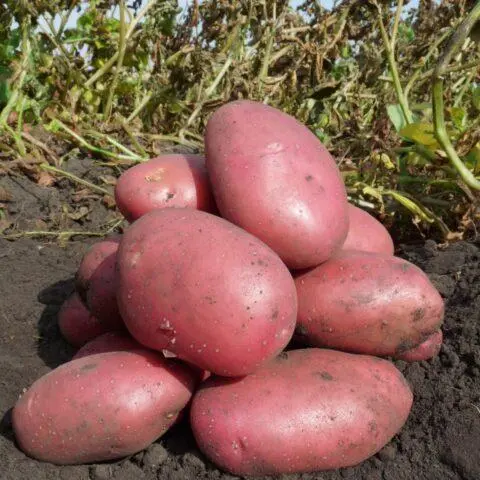
Potato Hostess is undemanding to the composition of the soil and growing conditions
The story of
This variety appeared thanks to the efforts of breeders of the Siberian Research Institute of Agriculture. The basis for it were the views: Zaryevo and Sante. The purpose of the creation was to obtain potatoes with high yields in regions with risky farming. And the variety fully lived up to expectations.
As a result, in 2004 an application was submitted for variety testing and registration of a new type of crop. After five years, it was included in the State Register, as it fully confirmed the declared characteristics.
Description of potato variety Hostess with photo
The appearance of the bushes and fruits of the hostess potato has a significant difference from other crop options. This makes it possible to accurately determine it during the growing season and storage.
Bush
Variety Khozyayushka is characterized by sprawling high bushes of an intermediate type, the height of which reaches 60-65 cm. The leaves of the Hostess are large, open, dark green in color with a strong waviness along the edge. Most of them are concentrated at the top of the bush. In the axils of the leaves of the hostess there is an anthocyanin color.
Inflorescences are compact, consisting of 3-4 buds. Corollas reddish-purple with white tips. Anthocyanin is present on the buds, but weakly expressed. The flowering of the variety is moderately plentiful. Berry formation is rarely observed.
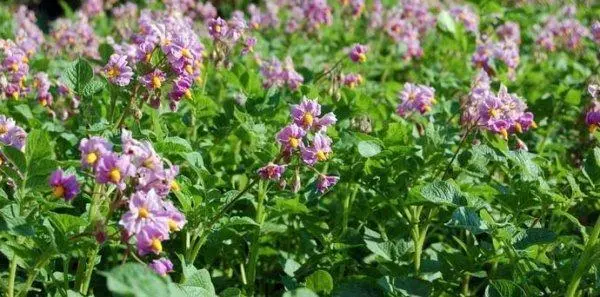
The flowering period of the hostess potato lasts no more than ten days
Tubers
The variety is distinguished by large, evened fruits of a rounded shape, weighing from 100 to 200 g. The peel is of a dark pink hue. The eyes are small, superficial, which reduces the amount of waste during cleaning. The yield of marketable tubers from the Hostess is 87-97%
The pulp is of a uniform cream shade, moderately dense. When exposed to air, it does not darken. In the process of cooking, the potatoes are boiled soft, but slightly. The starch content in tubers is 17-22%.
Under each hostess bush, 8-14 fruits are formed. And all of them are practically one-dimensional.

Tubers easily tolerate transportation and are suitable for long-term savings.
Characteristics of potato varieties Hostess
The productivity of each variety is determined by its characteristics. Therefore, in order to get a complete picture of the Hostess, you need to familiarize yourself with them.
Taste qualities of potatoes Hostess
Experts rate the taste of this type of potato as excellent. After cooking, the tubers retain their shape and have an appetizing appearance.
Potato Hostess is suitable for:
- first and second courses;
- salads;
- fries;
- chips.
Also, on the basis of this type, a delicious puree is obtained, which has a delicate and uniform texture.
Terms of ripening potatoes Hostess
This variety is considered a mid-season table variety. The duration of its growing season is 95-100 days. Harvesting is recommended in the first half of August.
Productivity
The hostess has a stable yield. Subject to the rules of planting and care, the variety shows productivity at the level of 300-380 kg/ha.
Where is grown
The Hostess potato is recommended for cultivation in two regions of the country, namely in East Siberian and West Siberian. The highest performance during the variety trials was recorded in the Omsk region.
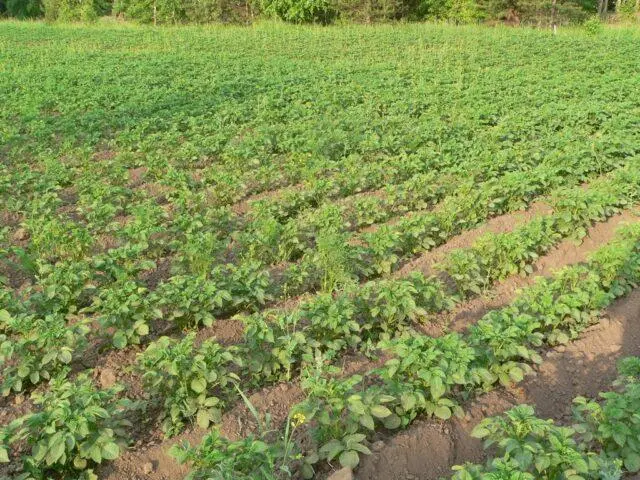
The variety is suitable for industrial and private cultivation.
Disease resistance
The hostess is immune to viruses, the golden nematode. But it has an average resistance to common scab, rhizoctoniosis, dry early spotting. Also, the variety is susceptible to late blight, and the tops are more susceptible to the disease than tubers. Therefore, it is recommended not to delay harvesting in order to minimize the likelihood of damage.
Advantages and disadvantages
This variety of culture has many advantages, which distinguishes it from other types of culture. But it also has weaknesses, which are recommended to pay attention to.
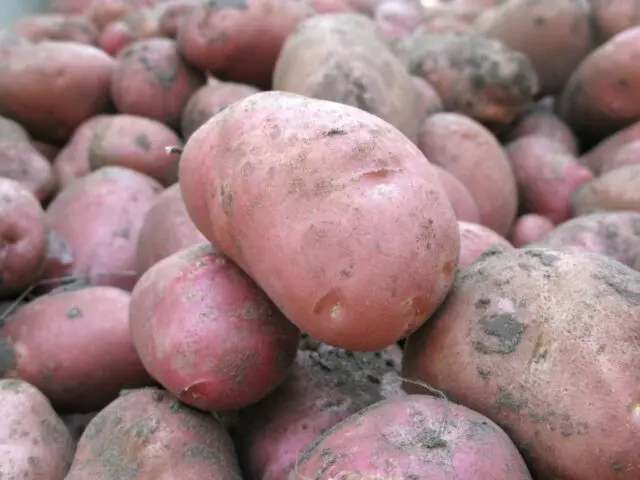
The variety is not very susceptible to mechanical damage.
Main advantages:
- versatility of application;
- excellent taste;
- a large yield of marketable tubers;
- resistance to adverse weather conditions;
- good keeping quality;
- undemanding to the composition of the soil;
- stable yield;
- tolerates transportation well;
- virus resistance
Disadvantages:
- susceptibility to late blight, rhizoctoniosis, dry spotting;
- requires compliance with crop rotation;
- tubers before planting are not recommended to be cut.
Features of landing
Before planting seed potatoes of the Hostess variety, it is recommended to germinate it. This will speed up germination and reduce the likelihood of damage to the bushes by late blight in August. For this, seed tubers must be brought into the room three weeks before planting in open ground and laid out in one layer. During the whole time it is recommended to maintain a temperature of +15 ° C and periodically turn them for uniform growth of sprouts. It is not recommended to cut the seed potatoes of the Hostess, as this negatively affects the further development of the bushes.
For this variety, it is necessary to choose open sunny areas, as much as possible illuminated throughout the day. In advance, the site must be dug up and humus added at the rate of 10 kg per 1 sq. m. The hostess shows good performance when grown in sandy and loamy soils with the addition of black soil. But it is also possible to grow a variety in clay soil, if you additionally add sand of their calculation of 10 kg per 1 sq. m.
It is recommended to make holes for potatoes Hostess at a distance of 35 cm, and maintain a distance of 60 cm between rows.
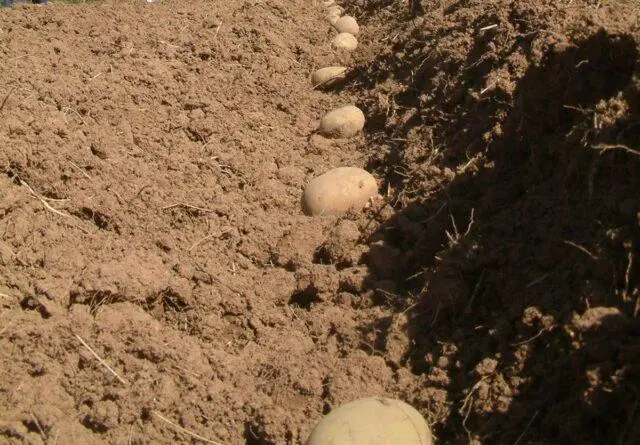
The optimum level of penetration on light soils is 10 cm, and on heavy soils – 7 cm.
Care instructions
When growing potatoes, the Hostess must adhere to standard agrotechnical measures.
The grade well maintains short-term drought without loss of productivity. Therefore, watering should be carried out only in the absence of rain for a long time. Moisturize in the evening by wetting the soil by 10 cm.
Ten days after planting, it is recommended to carry out the first loosening of the soil to a depth of 1 cm. This will prevent the formation of a crust on the soil surface and provide air access to the roots. In the future, you need to do weeding as weeds grow.
The first hilling of the hostess bushes is recommended at a shoot height of 13-15 cm, and the next one two weeks after the previous one.
The variety responds well to top dressing. The first time to apply fertilizers is necessary at the stage of active vegetation. At this time, you can use organic: chicken manure 1:15 or mullein 1:10. Nitroammophoska is also suitable in the proportion of 30 g per bucket of water.
The second and third time it is recommended to feed the hostess potatoes before and after flowering. During these periods, the use of superphosphate 30 g and potassium sulfide 25 g per 10 liters of water is relevant. Under each bush you need to pour 0,5-1 l of nutrient solution.
Collection and storage of potatoes Hostess
It is recommended to start harvesting at the end of the first decade of August. By this time, the shoots are already turning yellow and drying out, but the tubers are still holding on to the roots. Dig up potatoes in dry weather in the morning. After that, spread the tubers on the site and leave to dry for two hours. Then the harvested crop can be transferred to the room for further drying.
A month later, the potatoes need to be sorted out and immediately sorted into large, seed and small specimens. It is also necessary to discard damaged tubers, as they are not subject to further storage. It is recommended to save the harvest in the basement at a temperature of +4 ° C and a humidity of about 60%.
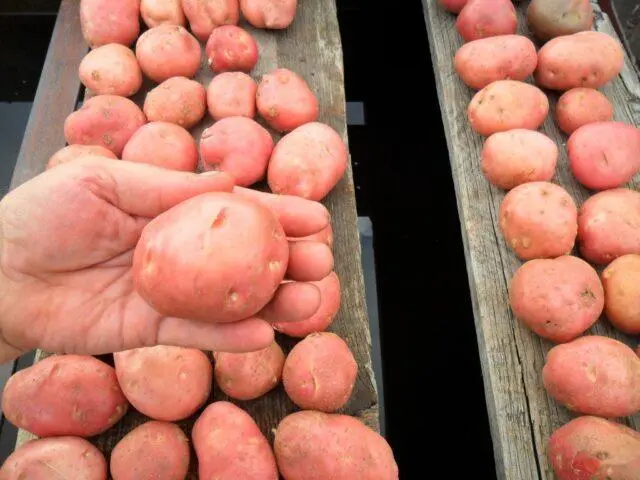
Seed tubers should be stored separately
Conclusion
Potato Hostess is a new variety that many gardeners could appreciate. After all, not every type of culture is able to show high productivity in regions with risky farming. In addition, its taste is also at its best, and the versatility of the use of fruits allows you to cook different dishes.









